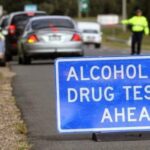Dangerous Driver Who Killed Pregnant Woman Wins Appeal

The court heard that Richard Moananu began drinking about 10am on 28 September 2018 before getting behind the wheel of his silver Mazda at around 6.45pm.
He collided head on into a car carrying a young man and his pregnant wife, who was due to give birth to twins in the coming days.
The agreed facts of the case detailed that Mr Moananu was driving in excess of 45km/h over the speed limit in the lead up to the crash, had run a red light, failed to indicate properly and was swerving before driving onto the median strip and becoming airborne at around 145km/h and landing on the wrong side of the road where the collision occurred.
He was driving on an expired driver licence.
Horrific crash
Waking from a coma after the crash, sole survivor Bronko Hoang, who suffered two punctured lungs, crushed intestines, a broken foot and bleeding on the brain, was told that his wife and their unborn children had died.
Plea and sentence
He pleaded guilty to two charges of manslaughter and one of aggravated dangerous driving occasioning grievous bodily harm, and was sentenced in November 2020 in the District Court of New South Wales to a prison term of 15 years with a minimum term of 10 years.
Appeal
Mr Moananu appealed the severity of his sentenced to the New South Wales Court of Criminal Appeal, which on Friday 22 April 2022 found the sentence to be ‘manifestly excessive’ and reduced it to 12 and a half years behind bars with a minimum term of eight years and four months.
In delivering the judgment, NSWCCA Justice Mark Leeming considered evidence that Mr Moananu was haunted by the incident and deeply remorseful.
His Honour also considered the appellant’s post-traumatic stress, dysfunctional childhood, as well as his “clean driving record prior to the accident.”
The Justice also took into account that Mr Moananu’s behaviour in custody “appears to be exemplary”, proceeding to remark:
“The evidence allows the court to take a more sanguine view to the applicant’s prospects of rehabilitation, although the sentence to be imposed must reflect the extraordinarily serious objective facts.”
Given the time he has already served behind bars, Mr Moananu will be eligible for parole in January 2027.
Appeals to the NSWCCA
The NSWCCA is the State’s highest court for criminal cases.
Any person who pleads or is found guilty of a crime in the Supreme Court or District Court judge may, after their sentence is finalised appeal to that court.
But unlike appeals from the Local to the District Court, during which the District Court judge must give what’s known as a ‘Parker Warning’ before they can impose a heavier sentence, allowing for the appeal to be withdrawn at that time, the NSWCCA does not need to give such a warning and is entirely at liberty to impose a heavier sentence on appeal.
The offence of dangerous driving occasioning in New South Wales
Dangerous Driving Occasioning Grievous Bodily Harm is an offence under Section 52A of the Crimes Act 1900 which carries a maximum penalty of 7 years in prison.
To establish the offence, the prosecution must prove beyond reasonable doubt that:
- You were the driver of a motor vehicle,
- You were involved in an impact that caused grievous bodily harm (GBH) to another, and
- You were under the influence of alcohol or drugs, or you were driving at a dangerous speed, or you were driving in a dangerous manner.
A ‘vehicle’ is defined as:
- Any motor car, motor carriage, motor cycle, or any other vehicle propelled, wholly or partly, by volatile spirit, steam, gas, oil, electricity, or by any other means other than human or animal power, or
- A horse-drawn vehicle.
An ‘impact’ is that which occurs:
- between an object or a person and the vehicle,
- between an object, including the ground, due to being thrown from the vehicle,
- with another vehicle or object in, on or near a person,
- with anything on or attached to the vehicle, or
- with anything in motion through falling from the vehicle.
It also includes where:
- a vehicle overturns or leaves the road, or
- a person falls or is thrown or ejected from the vehicle.
‘Grievous bodily harm’ is defined by the courts as ‘very serious harm’ it includes but is not limited to:
- Any permanent or serious disfigurement,
- The destruction of a foetus, other than by a medical procedure, and
- Any grievous bodily disease.
The maximum penalty increases to 11 years in prison where the offence is committed in ‘circumstance of aggravation’ which is where:
- You had a ‘prescribed concentration of alcohol’ in your bloodstream,
- You exceeded the speed limit by more than 45 km/h, or
- You were ‘very substantially impaired’ by a drug or drugs.
A ‘prescribed concentration of alcohol’ is a reading of at least 0.15.
You are presumed to have been under the influence of alcohol where you had the prescribed concentration of alcohol in your bloodstream.
A certificate of your alcohol or drug concentration is admissible as evidence as long as the analysis occurred within 2 hours after the impact, unless you are able to prove ‘on the balance of probabilities’ that the concentration was lower at the time impact.
A defence to the charge is that the death was not attributable in any way to:
- Being under the influence of alcohol or drugs
- The speed at which you drive, or
- The manner in which you drove.
Other defences include self-defence, duress and necessity.
What about the unborn children?
In November last year, the New South Wales Government passed two new laws which
Make it a specific crime to cause the loss of an unborn child through a criminal act.
The ‘Loss of Foetus’ Bill introduces two new offences. The first offence relates to situations where a crime leads to the death of an unborn child but the mother survives.
The law states:
(a) the person’s act or omission constitutes an offence under a Grevious Bodily Harm (GBH) provision (the relevant GBH provision), and
(b) the act or omission consists of, or includes, causing the loss of a foetus of a pregnant woman.
In a proceeding for an offence is not necessary for the prosecution to prove that the defendant knew, or ought reasonably to have known, that the woman was pregnant, unless that knowledge is an element of the relevant GBH provision.
Those found guilty of this offence will face five to 28 years behind bars.
The second offence relates to circumstances when an unborn child is lost because of the death of a pregnant woman as a result of a crime.
Offenders will serve three more years in prison for the loss of the foetus, in addition to any time they have to serve for killing the pregnant woman.
The amendment to the Crimes Act is the result of years of advocacy by expectant parents, in particular Brodie Donegan who lost her unborn baby girl, Zoe, on Christmas Day in 2009 when a drug-affected driver smashed into her.
The driver was sentenced over the injuries to Brodie, but escaped any punishment over the death of unborn Zoe because at that time, there was no separate offence under the NSW Crimes Act, to deal with the killing of an unborn child.
Going to court for a traffic offence?
If you are going to court for a traffic offence, call or email Sydney Criminal Lawyers anytime to arrange a free first consultation with an experienced, specialist traffic lawyer who will accurately advise you of your options, the best way forward, and fight for the optimal outcome in your specific situation.







